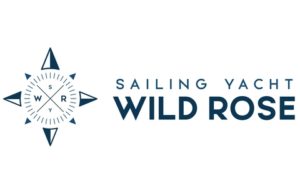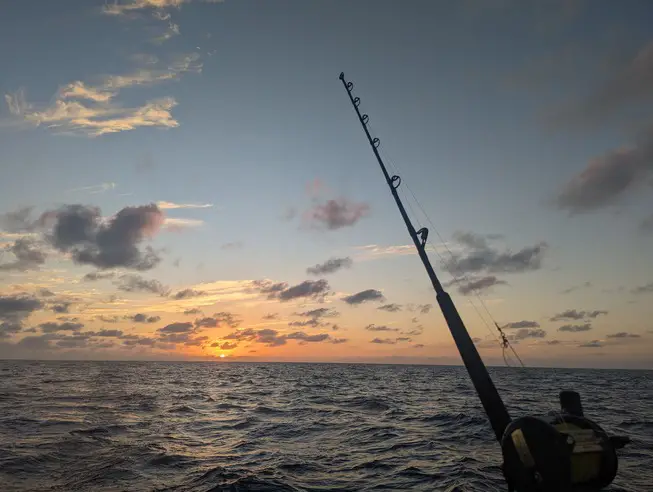A few stats about our passage from the Bahamas to the BVI.
- 0 injuries
- 1 – 40 knot squall
- 2 shooting stars
- Only 2 fish, one tuna and a small mahi
- 8 days
- 40 gallons of diesel used
- 50+ dolphins
- 965 nautical miles
The sea is a desert of waves, a wilderness of water.
–Langston Hughes
Wow, what a passage from the Bahamas to the British Virgin Islands. This was Nancy’s first long ocean voyage, everything before this was a few three-day sails. We had a little bit of everything, a 40 knot squall which was pretty hair raising. We had a day with no wind so we had to motor the whole day and night. We had a couple of days of really strong winds, 25 – 30 knots aft of the beam when we were surfing down waves under a triple reefed main and double reefed jib. We used only 40 gallons of diesel to go nearly 1000 miles, pretty good in my opinion since we did a lot of motoring and motor-sailing. When we motor, or motor-sail because of low winds we only use one motor, this is far more efficient than using two. We carry 175 gallons of diesel in our tanks and another 25 in jerry cans. Theoretically we could motor for 1000 miles under low RPM’s if we had to.
We had no injuries to report, which was good, the top two priorities on an ocean passage are taking good care of the boat and crew. Everything else is a luxury. Sailing short handed, as we are, we do three hour watches, so you only get about two hours of sleep at a time. Keeping up with proper hydration, getting calories into your body and proper hygiene is really all you have time for.

Pure Wilderness
Most people think about being out in the wilderness as going out in the woods or mountains, and that certainly can be wilderness. Sailing offshore hundreds of miles from land in a sailboat is truly being off grid in the wilderness. You only have your seamanship and skills to keep you alive. It can be flat calm or a raging ocean out there, there is no safe harbor nearby. It is an immense sense of responsibility and freedom that most people rarely get to experience in today’s modern world where most people are a 911 call and minutes from an emergency room. Out there you’re all alone. And the ocean can be a harsh teacher.
Preparation
Before going on an ocean passage there is a lot of prep work to be done. First you have to make sure the boat is in good order, full of fuel, fully provisioned, water, emergency water, ditch bag is assembled, jacklines installed, engines checked, rig inspected, etc. It took us about two and a half days to fully prep to head far offshore.
We prepare a bunch of food before heading off in case the weather is too rough to cook under way. It is nice to have food ready to heat in the microwave or stove top. Our go to is chicken and noodles and burritos, both are easy to re-heat and get some food in you when you need some calories. We also have a strict no alcohol policy on passage.

The Route
Going from the Bahamas to the Virgin Islands you have a few different options. Before I get into those, you have to realize that 95% of the time in the lower Bahamas and certainly the Caribbean the trade winds are blowing from east to west. They are relentless, and they blow 15 – 20 knots with 25 knot gusts nearly the entire time. So you have to find a way to go to the Caribbean against the wind, which is not fun. You cannot sail directly into the wind.
Option one, is to take what is called the Thorny Path. The Thorny Path is aptly named because you are sailing head to weather the entire time. There’s a reason they call it beating to weather, because your boat is constantly bashing into the wind and waves, it is a very uncomfortable ride. From where we were in the lower Bahamas to the Virgin Islands was about 700 miles. So I really wasn’t interested in beating into the wind for 700 miles. Now you do stop at different islands like the Dominican Republic and Puerto Rico, and you can sail only at night when the trades do decrease, but this can take weeks or months to wait for good weather.
The second option is to work your way down to the Turks and Caicos, which is not particularly friendly to sailors, and wait for a good weather window where the wind backs to go directly to Puerto Rico. This is probably the second best option.

The last option, and the one we chose, is called the I-65 route to the Virgins. You have to wait for just the right weather, but once you get a window, you motor or motor sail directly east for 5 days until you hit the 65th longitude line. It’s actually better to go a little past that, but you have to at least make it to longitude 65W. Then you turn due south and theoretically the trade winds start to fill in and you have a very nice beam reach right into the Virgin Islands. The entire route is longer, but it’s faster and easier on the boat and crew.
There’s a couple of issues with this route, one is it takes you hundreds of miles offshore, some people are not comfortable with that. The other is that if your weather window shifts or closes and the trades start to build before you get to 65W then you might find yourself winding up in the DR or Puerto Rico anyway. The weather predictions are only good for about five days, this is a roughly eight day route depending on conditions.
Safety First
Before heading out on an ocean passage we fill out a float plan and leave it with someone on shore that tells the details of the vessel, crew, departure and planned arrival time. We gather the ditch kit together with our boat documents, passports, credit cards, money, water, food handheld VHF and a host of other items.
We hire a professional weather router to help us with passage planning. This gives you a relatively decent weather prediction for about five days out as well as looking at the best times to leave port and the best route to sail.
We wear life jackets with tethers at night or in rough weather. The greatest risk is losing someone overboard, so our rule is if you are on watch alone at night you have to tether yourself to the boat. There is also no leaving the cockpit or helm area at night if you are the only one on deck. If you need to go forward you need to get someone else up. Every sailors worst nightmare is to wake up and find out someone is not on the boat. Our life jackets have a device that will alert the boat should someone go overboard, it will also alert any other boats in the area through a system called AIS.
Prior to going on passage we affix jacklines fore and aft so if you do need to go forward in rough weather or at night you have something to clip in to. On this particular passage there was never a time during rough weather or at night where we had to go forward of the helm. The only reason we went forward or up to the mast was to check for chafing and general rig inspection underway. Every day you need to check lines and sails for chafing as well as looking at all of the hardware to make sure everything is tight and where it should be.
We carry an EPIRB on board in case something were to happen to the boat and we had to ditch in the life raft. We also have a Garmin InReach communication device in case we had to ditch, we could message our shore support to get in touch with the USCG or other closer authorities. The most likely scenario where people do have to abandon their boat is that a cargo vessel, tanker, or other sailboat would be diverted to affect a rescue. We obviously hope this never happens to us, but we do have a good friend who had to be rescued because of a very serious injury out in the middle of the Atlantic. He was transferred to a container ship and brought back to land faster than they could have sailed. It was a very serious injury.
We also carry a pretty serious first aid kit aboard with antibiotics, pain meds, and just about everything we would need to get through something pretty serious at sea. We hired a specialist who is a Physicians Assistant, Jeff Fine out of Annapolis to do this.
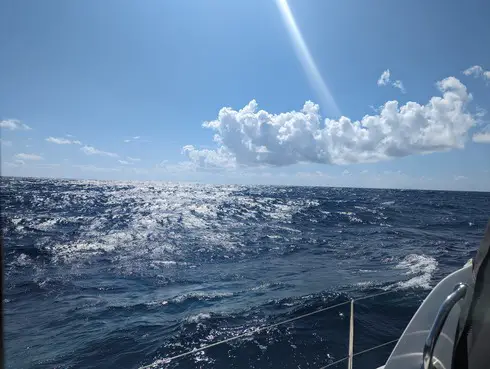
Magic
There are many reasons to go sailing, travelling and getting to pull your home up to a new country to explore at your leisure instead of a week or so on vacation. It is a lot of work, there are many hazards, and sometimes it can get uncomfortable. There are these truly magical moments at sea that make it all worthwhile, which is part of the reason we do this. One such moment for me was during our third night on passage. It was very calm and we were motoring along with nearly no wind, we didn’t even have any sails up. There was no moon, so you couldn’t see the horizon. Usually even on really dark nights you can still make out the horizon, but not on that night. All you could see was blackness and stars. There were no clouds in the sky and the stars and milky way were on full display. It felt like our little boat was floating in outer space. I am at a loss still to find the words to fully describe it, so I won’t even try.
Most days on passage are spent managing the sails, getting in a good nap, reading a book or listening to a podcast and fishing. You might fish for two days with nothing, then the high pitched scream of the reel goes off and you know you have something on. It could be anything from a small bonito or a giant wahoo. You need to potentially slow the boat down to reel in the fish, fight the fish, and the hardest part is landing it in rolling, pitching seas on the back of the boat while one person holds the rod and the other person gaffs it. Most of these pelagic ocean fish have pretty sharp teeth, so when you get the fish on deck you want to keep your fingers and toes out of their way, which is much easier said than done while the fish is flopping around on deck.
Several of the days it was pretty rough, so we didn’t fish, but overall it was pretty poor fishing. We tend to do pretty well on passage with the fish, but this was not a good passage for filling the freezer. Hopefully we will do better next time.

Pro Tip: When you are cleaning a saltwater fish, never rinse it in fresh water, only use salt water to rinse the fish, even before you put it in the fridge or freezer, just use sea water.
Landfall
After all of the planning, weather routing, sail changes, reefing, sleep deprivation, rough weather, beautiful open ocean sailing and just generally being at sea for a length of time, making landfall is a serious sense of accomplishment, especially after what I would call a sporty passage. Coming in to Tortola, because it is pretty tall, we could see it around 9am, but knew we wouldn’t reach an anchorage until the afternoon. It’s a long time to wait when you feel like it’s so close.
For me coming in to the BVI is a little like coming home. I worked there for several months in my early 20’s. Plus I’ve been back a couple times since. It’s a place I’ve always cherished and have been looking forward to getting back for a while. We’re both looking forward to spending about a month here. The British Virgin Islands is well regarded as the best place to sail in the world. It is a true sailors paradise.
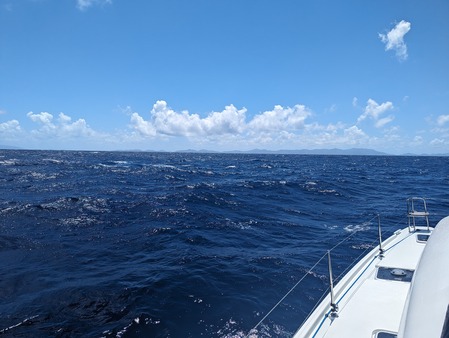
Formalities
A friend of mine asked a question about how the check in process works for different countries when arriving by sailboat. So here is the formality process from start to finish.
First upon arrival to a new country you raise a yellow Q flag (quarantine) on your starboard flag halyard. This signifies your intention to clear formalities to officially check in to the country. Upon arrival you are supposed to check in right away. If you arrive in the afternoon, or at night obviously you check in the next day. Once we arrived to St. Martin so exhausted at dawn that we had a couple of passage beers and slept the entire day. St. Martin is pretty relaxed about this, but some countries are nearly militant about checking in immediately upon arrival.
You need to gather all of the crew passports, the original boat documentation form, in our case our USCG registration, I also take our insurance form as well as the check out form from your previous country. Basically you are doing two things, you are checking in everyone on the boat, as well as checking the boat in to the country.
Then you put on a nice (and hopefully clean) shirt and shorts to look presentable and do not wear a hat or sunglasses. Some islands don’t care what you look like, but some want you presentable. It’s just a good idea to show the immigration officials respect.
You need to find the official office, or sometimes you have to go to a couple of offices, but you need to be able to find the dock to land the dinghy at. In the Bahamas it was a little room at the back of a building with no sign. I had to ask five people to even locate it. Most countries have several locations to clear in, so you try to find the one that’s the easiest by word of mouth on Facebook or other social media.
Every country has a different process, it can take ten minutes or three hours. The French islands are by far the easiest. You go to a little computer terminal, usually located in a chandlery or sometimes a coffee shop, and you enter your boat and crew information into the terminal, then the clerk prints out your clearance form and stamps your passports. Yes, I said a clerk, not a government official or immigration officer. It’s just a guy or girl checking people out at a store. The total process takes about 10 – 15 minutes. And there is no fee, or some places charge a nominal $2 fee.
In many countries you use an online portal to enter in all of your boat and crew information. The Bahamas has their own system, but a lot of the Caribbean countries use a system called Sail Clear at sailclear.com.
Some islands it is quite a process, you need to go to Immigration, then to Customs, then you go to a cashier to pay. Here in the BVI we even had to pay some money at the Port Authority. I think the total for the BVI was around $125 or so. It’s basically just a big money grab in some countries.
In the Dominican Republic you need to check in and out of every port or harbor. This usually involves a fee, and sometimes you even need to pay a little bribe. We have heard of many sailors who have had to pay bribes and some who have been charged excess fees without a receipt. This is basically a government official shaking down sailors for an additional $50 or $100. This was pretty common in the Bahamas, but we have not personally experienced this yet. And, to be quite honest this is one reason we decided to skip the Dominican Republic.
After you have your formalities completed you go back to the boat, take down the quarantine flag and put up the courtesy flag. I wrote an entire post on courtesy flag etiquette you can read here.
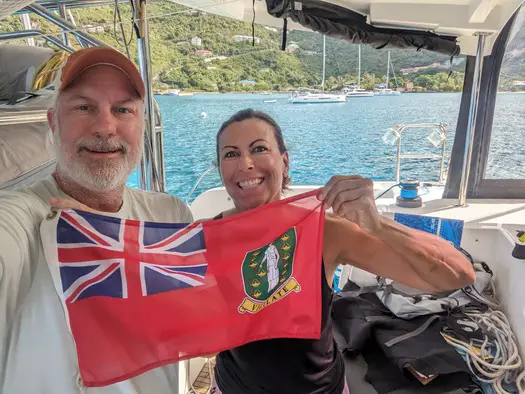
Ship Log
Sign up below to be added to our email list for the Ship Log. We only post once or twice a month.
